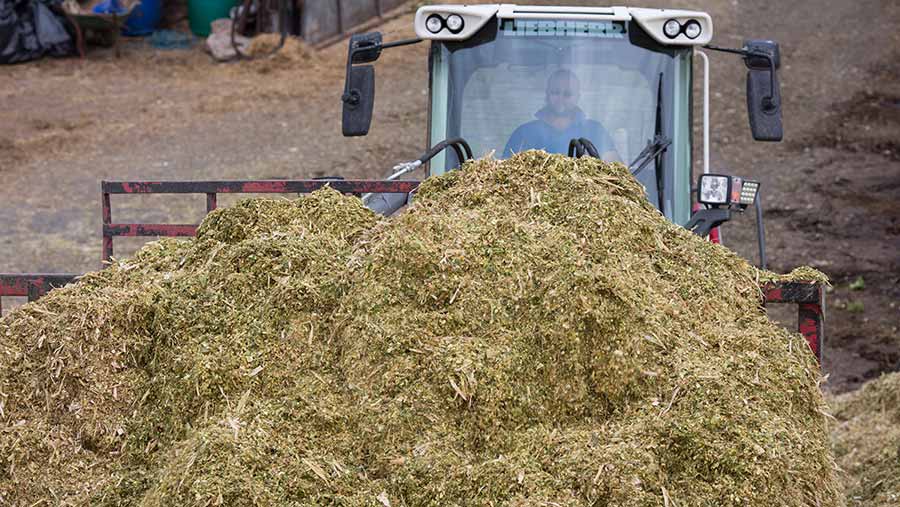7 tips on silage aftermath nutrition
 © Tim Scrivener
© Tim Scrivener Livestock farms looking to maximise silage production should avoid delays to aftercut fertilisers, which could result in cutting yields by 10% – or 370kg/ha – for each day of delay.
A rate of 2.5kg N/ha/day of ammonium nitrate-based fertiliser should be considered for farms disappointed with first-cut yields, according to CF Fertilisers’ Mark Garrett.
See the seven tips on silage aftermath nutrition below:
See also: Guide to fertiliser terminology and spreading equipment
1. Analyse soil and optimise levels
Having the correct pH, phosphate and potassium levels in your soil is the base to optimising yield. A pH of 5.5 can knock 40% off grass yield, compared with grass grown at a pH of 6.5.
Aim for:
- pH 6-6.5
- P index at 2
- K index at 2+
2. Apply slurry
Grass silage removes a lot of potash from the soil system, and slurry is a good source of both phosphate and potassium.
- An application of 1,000gal/acre of slurry (11cu m/ha) will supply about 25% of your post-cut potash requirement
- Do not apply more than 3,000gal/acre (33cu m/ha).
3. Monitor compaction
Compacted soils lack the air and water needed to let regrowing grass roots access the nutrients they require for regrowth. It can reduce post-cut yields by up to 25%.
Dig inspection pits and assess compaction so any issues can be rectified next autumn.
4. Know how much fertiliser you need
Slurry alone will not supply enough nitrogen for optimal yields.
It’s important to know how much nitrogen, phosphate, potassium and sulphur is being applied with slurries and bagged fertilisers.
Every 1,000gal/acre (11cu m/ha) slurry only contains enough nitrogen to grow about 0.75t/ha of grass.
- A four-cut system requires up to 90kg N/ha (72 units/acre) to grow second-cut
- A three-cut system requires about 75kg N/ha (60 units/acre) to grow second-cut
- A two-cut system only requires 50kg N/ha (40 units/acre) to grow second-cut
5. Do you use urea or ammonium nitrate?
Urea and ammonium nitrate behave very differently, with urea disappearing into the atmosphere through a process called volatilisation.
If urea is applied in warm and dry conditions, farmers could lose up to 58% of the nitrogen to the atmosphere, affecting growth potential by up to 15%.
So, while ammonium nitrate is more expensive, it doesn’t disappear into the atmosphere, independent grassland scientist Dr George Fisher told Farmers Weekly.
Dr Fisher said only 2-3% of ammonium nitrate might be lost to volatilisation, whereas 25-30% of urea could typically disappear into the atmosphere.
6. Consider sulphur
All soil types – apart from heavy (clay loam) and peaty soils – will respond to added sulphur fertiliser and give more dry matter yield, crude protein content and sugar levels.
- Apply 20-25kg sulfur trioxide/ha (16-20 units/acre) across aftermaths to optimise yield and quality.
- A slurry application only provides about 2kg sulfur trioxide/ha.
- Cattle slurry does not contain much sulphur and 85% or more of the sulphur in slurry is unavailable for plant use.
7. Compound fertiliser or blend?
A true granular compound contains all the nutrients in each individual granule, whereas a blend is a mix of different granules, with each granule supplying different nutrients.
The effect is that blends are cheaper – due to lower processing costs – but are far less reliable, as granules can be different sizes and weights, affecting their passage through the hopper, through the air and onto the plants.
Compounds and blends both provide the crop with what it needs, but blends can result in 15% lower yields in grassland due to an imbalanced supply of nutrients reaching the plants.
Silage quiz
Livestock farms looking to maximise silage production can take an online quiz to inform summer fertiliser plans.
A simple seven-step questionnaire about silage systems and management has been developed by CF Fertilisers to offer farms recommendations on fertiliser plans this summer.
Mark Garrett, CF Fertilisers, said: “This quiz is designed to help grassland producers recognise the important stages in the decision-making process and also help point them in the right direction when it comes to fertiliser choice required to help them meet their objectives.”
Take the CF AfterCut Silage Health Check quiz
